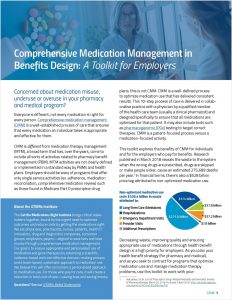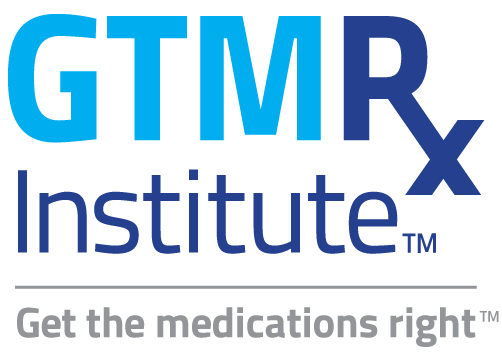 GTMRx Institute Unveils Tools and Strategies to Help Employers Navigate Health Plans and Adopt Comprehensive Medication Management Practices
GTMRx Institute Unveils Tools and Strategies to Help Employers Navigate Health Plans and Adopt Comprehensive Medication Management Practices
Institute Focused On Getting The Medications Right Reports Savings Up to $1,000 Per Participating Employee Per Year with CMM
Tysons Corner, VA — April 28, 2021 — Today, The Get the Medications Right™ (GTMRx) Institute, a catalyst for change that brings critical stakeholders together who are bound by the urgent need to get the medications right, is unveiling the GTMRx Employer Toolkit. This suite of resources is designed to equip employers with the knowledge to manage their pharmacy and medical benefit programs effectively. Evidence points to the value of comprehensive medication management (CMM) services as part of a “buy right” strategy to decrease waste and enhance quality; in fact, studies show a reduction in annual total health care costs of $1,000 per participating member on average for those who engage CMM.
“Employers manage health benefits for nearly half the country, and we need to ensure they have access to the right tools to create plan designs that get the medications right, particularly for those with multiple chronic conditions, seeing multiple physicians and taking multiple medications,” said Katherine H. Capps, co-founder and executive director of The GTMRx Institute. “The GTMRx Employer Toolkit is a first-of-its kind resource designed to offer a step-by-step approach to help employers work with their vendors to develop programs that manage medication misuse, overuse and underuse and avoid unnecessary waste.”
Core to The GTMRx Institute’s approach is comprehensive medication management, a push toward a more integrated approach to managing medication therapy problems. CMM is personalized, patient-centered and involves the physician working in collaborative practice with a clinical pharmacist and other team members to ensure appropriate use of medications. “Studies have shown that employers who engage CMM benefits not only decrease employee absenteeism, but also reduce emergency room visits and improve employee health; this is especially important for those with chronic conditions such as diabetes and cardiovascular disease,” said Cheryl Larson, president and CEO of Midwest Business Group on Health and GTMRx Employer Toolkit Taskforce member. “CMM makes sense when so much we are doing today is not working. The evidence shows that this is a vital pathway forward.”
The GTMRx Employer Toolkit & Resource Center offers guidance for employers on how to engage medical carriers, PBMs and other vendors and urges them to use their contract authority to prioritize CMM as a value-driving service. Leveraging deep insights from the GTMRx Employer Toolkit Taskforce, including leaders from the nation’s leading top health care business coalitions, the GTMRx Institute is outlining three steps for employers to take to move toward better health plans:
- Know What You’re Asking For: Arm yourself with knowledge ahead of discussions with your vendors. Medical carriers, pharmacy benefit managers (PBM) and the like may not be familiar with CMM. Ask them to share their solutions that are designed to manage medication problems that move beyond adherence programs and be open to pilot programs designed to meet the goal of managing medication misadventures on an ongoing basis. Ask your medical carrier, third party administrator and PBM to work with you to create trend reports that identify those members in greatest need for CMM services and track their progress.
- Align Internally and Get Buy-In: Use the data you’ve gathered to gain leadership support within your organization. CMM averages a return on investment around 3:1 to 5:1 the first year, something that may make the sell-in more attractive for your C-suite. Once you have buy-in from the top, ask your brokers to identify new products and services designed to manage medication therapy problems through CMM.
- Use Your Contract Authority and Make Your Move: Be prescriptive in designing contracts to center optimized medication use as an overall patient care and health benefit strategy; use the benefit plan design to shape vendor response and encourage innovative product solutions. Finally, be sure to work with your employer health care coalition and work with primary care providers in your community to identify how you can support advanced primary care services designed to optimize medication use reimbursed through your medical plan design.
“Innovative health plans should be paying for comprehensive medication management services that leverage a clinical pharmacist working in collaborative practice with physicians if they are serious about managing costs, increasing quality and ensuring appropriate care,” said Paul Grundy, MD, President of GTMRx. “We want to help employers realize their power in designing health plans that put medication optimization front and center.”
For more information on GTMRx and how they are moving the needle, visit http://www.gtmr.org.

